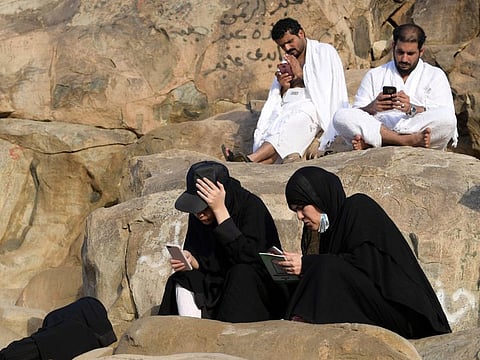Faith 2.0: Technology improves pilgrims’ Hajj experience
Classic watches and alarm clocks lose ground to phone-based tools

Mina, Saudi Arabia: The Hajj has been accelerating the growth of digital worship and spawning a slew of religious apps, tablet Qurans and faith-based gadgets.
This year, at the peak of Mount Arafat, numerous pilgrims were absorbed in Quranic verses displayed on their smartphones — rapidly replacing traditional printed holy books.
“Of course I read the Quran on my phone... it’s much more simple,” said Egyptian teacher Ahmad Salim, 46, who had travelled to Saudi Arabia for the Hajj.
For the first time in the Hajj’s history, 5G super high-speed mobile technology was deployed around the holy sites to allow the faithful to transfer data at breakneck speeds.
Tech giants Zain and Nokia will even “demonstrate advanced virtual reality... allowing users to experience the Hajj remotely as if they were there”, using 360 degree high-definition video over 5G.
Many pilgrims snapped selfies over the five-day ritual and sent video clips to friends and family back home.
Almost 2.5 million Muslims travelled to Makkah for the religious gathering, which is one of the world’s largest and most logistically complex.
The Hajj has taken on an increasingly high-tech dimension in recent years with the emergence of mobile phone apps designed to help pilgrims from around the world navigate their experience.
Software exists to help visitors get around Makkah and the surrounding area as well as access medical services and properly follow religious rites.
Saudi’s Hajj ministry even sends text messages to pilgrims with a variety of information and advice.
A major digital innovation for this year’s Hajj has been the introduction of electronic Hajj visas “delivered online for the first time without necessitating a consulate visit. It’s been a success,” said Hajj ministry official Hassan Qadi.
“It’s very practical, especially for those travelling with family,” said Jordanian Abdur Rahman Shdaifat, 44, making his first Hajj.
The authorities have also increasingly turned to technology to improve the Hajj experience and avoid incidents like the stampede that claimed some 2,300 lives in 2015.
In the wake of that tragedy, pilgrims are now issued with electronic bracelets containing their personal data.
“All of their information is loaded, a bit like an ID card. If you can’t read or write and you get lost, you can give it to anyone and they can help you find your address. Technology helps ease the Hajj,” said Sami Abdul Aziz, a 37-year-old Saudi pilgrim.
Shdaifat, sheltering under an umbrella from the heavy rains that lashed the Mina Valley outside Makkah, said of the bracelets: “If a pilgrim gets separated, their group can locate them. It’s very useful.”
Saudi authorities also fitted GPS trackers to 18,000 shuttle buses to monitor the flow of pilgrims.
Shdaifat brandished a second bracelet that gave him access to the metro system connecting Makkah’s various pilgrimage sites.
Classic watches and alarm clocks are also losing ground to phone-based tools that alert worshippers to their five daily prayers.
“Nearly all the pilgrims have it,” said Egyptian Ahmad Salim.
Sign up for the Daily Briefing
Get the latest news and updates straight to your inbox


